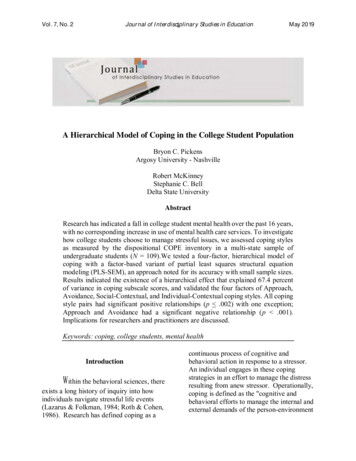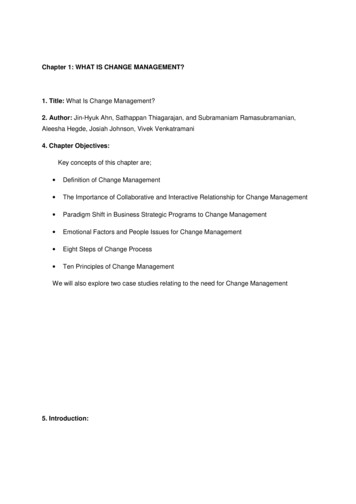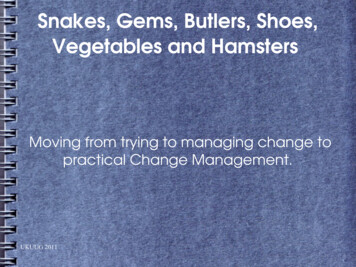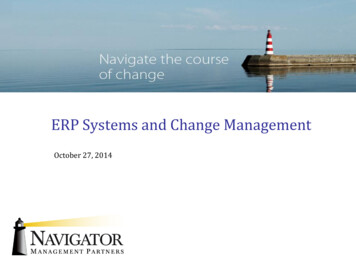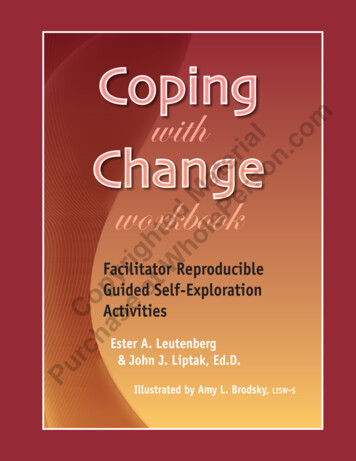
Transcription
Coping with Change Introductionrc Coha pse yriat ghW tedho Mle atPe errs orkbookFacilitator ReproducibleGuided Self-ExplorationActivitiesFacilitator ReproducibleGuided Self-ExplorationEster A. LeutenbergActivities& John J. Liptak, Ed.D.Ester A. Leutenberg& John J. Liptak, Ed.D.PuIllustrated by Amy L. Brodsky, lisw-sIllustrated by Amy L. Brodsky, lisw-sDuluth, Minnesota 2011 Whole Person Associates, 210 West Michigan St., Duluth MN 55802-1908 800-247-6789i
rc Coha pse yriat ghW tedho Mle atPe errs ialon.comCoping with Change IntroductionWhole Person210 West Michigan StreetDuluth, MN leperson.comCoping with Change WorkbookFacilitator Reproducible Guided Self-Exploration ActivitiesCopyright 2011 by Ester A. Leutenberg and John J. Liptak.All rights reserved. Except for short excerpts for review purposesand materials in the assessment, journaling activities, andeducational handouts sections, no part of this book may bereproduced or transmitted in any form by any means, electronicor mechanical without permission in writing from the publisher.Self-assessments, exercises, and educational handouts are meantto be photocopied.All efforts have been made to ensure accuracy of the informationcontained in this book as of the date published. The author(s)and the publisher expressly disclaim responsibility for anyadverse effects arising from the use or application of theinformation contained herein.Printed in the United States of America10 9 8 7 6 5 4 3 2 1PuEditorial Director: Carlene SippolaArt Director: Joy Morgan DeyiiLibrary of Congress Control Number: 2011927805ISBN: 978-1-57025-257-0 2011 Whole Person Associates, 210 West Michigan St., Duluth MN 55802-1908 800-247-6789
Coping with Change IntroductionUsing This Bookrc Coha pse yriat ghW tedho Mle atPe errs ialon.comIn today’s society, many people find themselves living through multiple extensive andoften debilitating changes in their lives. Your clients are among the people affected bythese changes. Change manifests itself in many facets of a person’s life. Workplace – Because the work world is changing, people find themselvesexperiencing a variety of changes: corporations outsourcing jobs to other partsof the world or they are being eliminated to save corporations money; robots arereplacing human employees; retirement savings are diminishing or disappearingdue to the downturns in the economy; and competition has increased for newlycreated jobs. Health – As society changes and people finding themselves trying to keep up,they experience more stress and anxiety. This increase in anxiety and stress thenleads to more physical illnesses, psychological problems, changes in eating habits,increased injuries, and sleeping issues. Home & Family – Ways people experience a sense of home and familyhave changed dramatically in recent years. Some of these changes includefragmentation of families through divorce and separation or extended absencesof one or both parents who must fulfill military responsibilities; single-parenthouseholds or decisions to send children to grandparents or other relatives;changing traditions in family celebrations or the absence of family traditions; andtime constraints preventing meaningful family interactions. Personal – Changes in people’s personal and social lives may be some of thebiggest changes people experience. Some of these changes include financialstruggles due to overspending and major debt, job loss, cultural differences,changes in residence, and the struggle to keep up with changes in technology.Because of constant changes in daily life, people face perpetually increasing levels ofstress. Although change has always been a part of the lives of human beings, the presentrate of changes is increasing exponentially. It is the speed of change that increases the stressin peoples’ lives. Change is not going to stop, and therefore, people must develop skillsto manage stress carefully. Coping with change is rapidly becoming a critical life skill thatcan be the difference between living a life of success or one of disappointment.PuEveryone adapts to change differently. The important tactic for each individual is tomaster the basic skills that are critical to move through change easily and effectively.This book provides assessments and self-guided activities to help people learn effectiveskills for coping with all forms of change. A variety of self-exploration activities areprovided for you to determine which best suit the unique needs of your participants. 2011 Whole Person Associates, 210 West Michigan St., Duluth MN 55802-1908 800-247-6789iii
Coping with Change IntroductionInformation about Changerc Coha pse yriat ghW tedho Mle atPe errs ialon.comMoving through change can be difficult. The path through change is probably notgoing to be predictable or smooth for most people. Usually people navigate changeand transition by moving through a series of five stages:STAGE 1: SHOCK – People in this stage attempt to deny the news about a currentor future change. They might say things like “No, not me!” or “It can’t be true!” Thisstage is full of anxiety and runs its course in a relatively short time. It is considereda state of denial.STAGE 2: ANGER – In this stage people begin to get angry. Initially they feel angertoward the people they feel are responsible for their change and blame others.After they have expressed their anger at outside sources, they may feel angry atthemselves. Their anger is turned inward and becomes self-critical. They may saythings like “If only I . . .” or “If I would have . . . ”STAGE 3: BARGAINING – People in this stage become calculating and reflective.Some attempt to make a deal with their higher power or the people involved inthe change process. As their attempts to compromise fail, they usually give up andmove to the next stage. They ask such questions as “What can I do now?” or “Pleasegive me another chance.” They try to identify their options and wish that thingscould be different.STAGE 4: DEPRESSION – People in this stage begin to feel sad and / ordepressed and think there are limited or no options. They often become silentand withdrawn. They begin to experience increasing weakness, discomfort andpersonal deterioration. They may feel a sense of meaninglessness, frustration, selfdoubt, and lethargy, and they may want to be left alone. They may feel guilty andunworthy and feel as if nobody cares what happens to them.PuSTAGE 5: ACCEPTANCE – People in this stage are at the end of their struggle. Theyaccept that change happens to everyone, that changes can be overcome, and that achange may even be an opportunity. They focus on the realities of the situation andbegin to let go of their negative feelings. They notice that the pain begins to lessenand the struggle seems less difficult. They recognize that it is time to move on withtheir lives. They accept their new normal.iv 2011 Whole Person Associates, 210 West Michigan St., Duluth MN 55802-1908 800-247-6789
Coping with Change IntroductionHow Change Affects PeopleFor the Facilitator and the ParticipantFacts about change:rc Coha pse yriat ghW tedho Mle atPe errs ialon.com1. Change is a part of life. It is important to be able to cope with and managechange effectively.2. All people go through a cycle of thoughts and emotions of some degree whenthey encounter change in their life. They need to keep in mind that thesethoughts and emotions will not last. It is necessary to go through the stages inorder to cope effectively with the change. The assessments, activities and exercisescontained in this workbook will help people to move through the stages toacceptance more quickly.3. Change can be managed. By completing the activities and exercises included inthis workbook, participants will be able to not only cope with change, but to usechange as opportunities for welcome and exciting transformations.4. It is important for people to take control over changes in their life by takingresponsibility for how they respond to the changes. They learn that they have thepower to control what they think, feel and do. They recognize that they can carefor themselves and relate effectively with others close to them.Responding to Change:Change produces unique signals that people can learn to read so they can respond tothem sooner. The sooner they are able to take action to cope with their change andultimate transition, the more likely they are to be effective in the change managementprocess. When they find themselves going through a change, they will be alert to thesignals produced by body, mind and emotion.Emotions – People need to be aware when they are experiencing changes in their moodsand feelings. Some of these changes might include feelings of anger, increased anxiety,moodiness, frustration, depression and withdrawal. Their behaviors may also includelashing out at others.PuMind – People need to be aware when they begin to have excessive negative thoughts thatcause confusion, distraction, difficulty in concentrating at home and at work, a decrease inproductivity, an increase in forgetfulness, and difficulty “turning their mind off” at nightto sleep.Body – People need to be aware of their body’s negative reactions to the change processincluding such symptoms as an increase in headaches, colds, and flu symptoms, digestionproblems, minor aches and pains, major illnesses, feelings of exhaustions, and muscleaches and pains. 2011 Whole Person Associates, 210 West Michigan St., Duluth MN 55802-1908 800-247-6789v
Coping with Change IntroductionFormat of Bookrc Coha pse yriat ghW tedho Mle atPe errs ialon.comThe Coping with Change Workbook contains assessments and guided self-explorationactivities that can be used with a variety of populations to help participants cope moreeffectively with the various forms of anxiety. Each chapter of this workbook beginswith an annotated Table of Contents with notes and examples for the facilitator. Eachchapter contains two primary elements: 1) A set of assessments to help participantsgather information about themselves in a focused situation, and 2) a set of guided selfexploration activities to help participants process information and learn more effectiveways of behaving to cope with anxiety in their lives.AssessmentsEach chapter begins with an assessment that provides participants with valuableinformation about themselves. These assessments can enhance recognition of effectiveand ineffective patterns of behavior, identify life skills which are productive andunproductive, and enrich participants’ understanding of how they interact with the world.Assessments provide a path to self-discovery through the participants’ exploration of theirown unique traits and behaviors. The purpose of these assessments is not to “pigeonhole” people, but to allow them to explore various elements that are critical for copingwith anxiety. This book contains self-assessments and not tests. Traditional tests measureknowledge or right or wrong responses. For the assessments provided in this book,remind participants that there are no right or wrong answers. These assessments ask onlyfor opinions or attitudes about topics related to a variety of coping skills and abilities.The assessments in this book are based on self-reported data. In other words, the accuracyand usefulness of the information is dependent on the information that participantshonestly provide about themselves. All of the assessments in this workbook are designedto be administered, scored, and interpreted by the participants as a starting point for themto begin to learn more about themselves and their coping skills. Remind participantsthat the assessments are exploratory exercises and not a final determination of abilities.Lastly, the assessments are not a substitute for professional assistance. If you feel any ofyour participants need more assistance than you can provide, please refer them to anappropriate professional.As your participants begin the assessments in this workbook give these instructions:Pu Take your time. Because there is no time limit for completing the assessments,work at your own pace. Allow yourself time to reflect on your results and howthey compare to what you already know about yourself. Do not answer the assessments as you think others would like you to answerthem or how you think others see you. Remember that these assessments are foryou to reflect on your life and explore some of the barriers that are keeping youfrom living a calmer, more rational and less anxious life.vi 2011 Whole Person Associates, 210 West Michigan St., Duluth MN 55802-1908 800-247-6789
Coping with Change IntroductionFormat of Book (Continued)rc Coha pse yriat ghW tedho Mle atPe errs ialon.com Assessments are powerful tools if you are honest with yourself. Take your timeand be truthful in your responses so that your results are an honest reflectionof you. Your level of commitment in completing the assessments honestly willdetermine how much you learn about yourself. Before completing each assessment, be sure to read the instructions. Theassessments have similar formats, but they have different scales, responses,scoring instructions and methods for interpretation. Finally, remember that learning about yourself should be a positive andmotivating experience. Don’t stress about taking the assessments or finding outabout your results. Just respond honestly and learn as much about yourselfas you can.Guided Self-Exploration ActivitiesGuided self-exploration activities are any exercises that assist participants in self-reflectionand enhance self-knowledge, identify potential ineffective behaviors, and teach moreeffective ways of coping. Guided self-exploration is designed to help participants make aseries of discoveries that lead to increased social and emotional competencies, as well asto serve as an energizing way to help participants grow personally and professionally.They are brief, easy-to-use self-reflection tools designed to promote insight and selfgrowth. Many different types of guided self-exploration activities are provided for youto pick and chose the activities most needed by your participants and / or will be mostappealing to them. The unique features of self-guided exploration activities make themusable and appropriate for a variety of individual sessions and group sessions.Features of Guided Self-Exploration Activities Quick, easy and rewarding to use – These guided self-exploration activities aredesigned to be an efficient, appealing method for motivating participants toexplore information about themselves - including their thoughts, feelings, andbehaviors - in a relatively short period of time.Pu Reproducible – Because the guided self-exploration activities can be reproducedby the facilitator, no more than the one book needs to be purchased. You mayphotocopy as many items as you wish for your participants. If you want to addor delete words on a page, make one photocopy, delete and / or write your ownwords, and then make photocopies from your personalized master. Participative – Guided self-exploration activities help people to focus theirattention quickly, aid them in the self-reflection process, and define new andmore effective ways of coping. 2011 Whole Person Associates, 210 West Michigan St., Duluth MN 55802-1908 800-247-6789vii
Coping with Change IntroductionFormat of Book (Continued)rc Coha pse yriat ghW tedho Mle atPe errs ialon.com Motivating to complete – Guided self-exploration activities are designed to bean energizing way for participants to engage in self-reflection and learn aboutthemselves. Various activities are included to enhance the learning process relatedto developing important social and emotional competency skills. Low risk – Guided self-exploration activities are designed to be less riskythan formal assessments and structured exercises. They are user-friendly, andparticipants will generally feel rewarded and motivated after completing theseactivities. Adaptable to a variety of populations – The guided self-exploration activities canbe used with many different populations, and they can be tailored to meet theneeds of the specific population with whom you work. Focused – Each guided self-exploration activity is designed to focus on a singlecoping issue, thus deepening the experience for participants.Pu Flexible – The guided self-exploration activities are flexible and can be usedindependently, or to supplement other types of interventions.viii 2011 Whole Person Associates, 210 West Michigan St., Duluth MN 55802-1908 800-247-6789
Coping with Change IntroductionChapter Elementsrc Coha pse yriat ghW tedho Mle atPe errs ialon.comThe Coping with Change Workbook is designed to be used either independently or as part ofan integrated curriculum. You may administer any of the assessments and the guided selfexploration activities to an individual or a group with whom you are working, or you mayadminister any of the activities over one or more days. Feel free to pick and choose thoseassessments and activities that best fit the outcomes you desire.The first page of each chapter begins with an annotated Table of Contents with notesand examples for the facilitator.Assessments – Assessments with scoring directions and interpretation materials begineach chapter. The authors recommend that you begin presenting each topic by askingparticipants to complete the assessment. Facilitators can choose one or more, or all of theactivities relevant to their participants’ specific needs and concerns.Guided Self-Exploration Activities – Practical questions and activities to prompt selfreflection and promote self-understanding are included after each of the assessments.These questions and activities foster introspection and promote pro-social behaviors andcoping skills. The activities in this workbook are tied to the assessments so that you canidentify and select activities quickly and easily.The activities are divided into four chapters to help you identify and selectassessments easily and quickly:Chapter 1: Types of Change – This chapter helps participants identify and explorethe changes that are currently occurring in their lives, as well as identify and explorethe changes they anticipate in the future.Chapter 2: Change Management – This chapter helps participants identify the lifeskills they possess in managing the changes in their lives.Chapter 3: Ways to Cope with Change – This chapter helps participants to explorehow well they are coping with change in their lives, and to learn some techniques forenhancing their ability to cope with change.PuChapter 4: My Attitude About Change – This chapter helps participants explore theirattitudes related to future change in their lives.Thanks to . . .Amy Brodsky, LISW-S, illustrator extraordinaire,and to the following professionals whose input in this book has been invaluable!Kathy Liptak, Ed.D.Carol Butler, MS Ed, RN, CEileen Regen, M.Ed., CJEKathy Khalsa, MAJS, OTR / LJay Leutenberg 2011 Whole Person Associates, 210 West Michigan St., Duluth MN 55802-1908 800-247-6789ix
Coping with Change IntroductionTable of ContentsTypes of Change Scalerc Coha pse yriat ghW tedho Mle atPe errs ialon.comTypes of Change Introduction . . . . . . . . . . . . . . . . . . .15Scale: Types of Change . . . . . . . . . . . . . . . . . . . . . 16–17Scoring Directions . . . . . . . . . . . . . . . . . . . . . . . . . . . . 18Profile Interpretation . . . . . . . . . . . . . . . . . . . . . . . . . 18Stages of Change . . . . . . . . . . . . . . . . . . . . . . . . . . . . .19“ Be Afraid of Standing Still” . . . . . . . . . . . . . . . . . . 20What am I Feeling? . . . . . . . . . . . . . . . . . . . . . . . . . . . 21The “What If” Game . . . . . . . . . . . . . . . . . . . . . . . . . . .22Monitor Your Self-Thoughts . . . . . . . . . . . . . . . . . . . . 23Joy . . . . . . . . . . . . . . . . . . . . . . . . . . . . . . . . . . . . . . . . 24Accepting Change and Acknowledging Feelings . . . . 25Let Go of Your Feelings in a Healthy Way . . . . . . . . . 26Share Your Feelings . . . . . . . . . . . . . . . . . . . . . . . . . . . 27Getting Stuck in Your Feelings . . . . . . . . . . . . . . . . . . .28Viewing the Future . . . . . . . . . . . . . . . . . . . . . . . . . . . . 29Moving from the Past . . . . . . . . . . . . . . . . . . . . . . . . . 30Saying Good-bye . . . . . . . . . . . . . . . . . . . . . . . . . . . . . 31Blaming . . . . . . . . . . . . . . . . . . . . . . . . . . . . . . . . . . . . 32Change Management ScalePuChange Management Introduction . . . . . . . . . . . . . .35Scale: Change Management . . . . . . . . . . . . . . . . . 36–37Scoring Directions . . . . . . . . . . . . . . . . . . . . . . . . . . . . 38Profile Interpretation . . . . . . . . . . . . . . . . . . . . . . . . . 38Scale Descriptions . . . . . . . . . . . . . . . . . . . . . . . . . . . . 39What is Your Coping Style? . . . . . . . . . . . . . . . . . . . . 40Change Process . . . . . . . . . . . . . . . . . . . . . . . . . . . . . . 41Change Poetry . . . . . . . . . . . . . . . . . . . . . . . . . . . . . . .42What’s the Worst that Could Happen? . . . . . . . . . . . 43Positive Self-Talk . . . . . . . . . . . . . . . . . . . . . . . . . . . . .44Change Debate . . . . . . . . . . . . . . . . . . . . . . . . . . . . . . 45Newspaper Article . . . . . . . . . . . . . . . . . . . . . . . . . . . . 46My Change Management Skills. . . . . . . . . . . . . . . . . . 47My Change Cartoon Strip . . . . . . . . . . . . . . . . . . . . 48Why? . . . . . . . . . . . . . . . . . . . . . . . . . . . . . . . . . . . 49–50Signature Strengths . . . . . . . . . . . . . . . . . . . . . . . . . . . 51Doodling . . . . . . . . . . . . . . . . . . . . . . . . . . . . . . . . . . . 52x 2011 Whole Person Associates, 210 West Michigan St., Duluth MN 55802-1908 800-247-6789
Coping with Change IntroductionTable of Contents (continued)Ways to Cope with Change Scalerc Coha pse yriat ghW tedho Mle atPe errs ialon.comWays to Cope with Change Introduction . . . . . . . . . 55Scale: Ways to Cope with Change . . . . . . . . . . . . 56–57Scoring Directions . . . . . . . . . . . . . . . . . . . . . . . . . . . . 58Profile Interpretation . . . . . . . . . . . . . . . . . . . . . . . . . 58Slow Down! . . . . . . . . . . . . . . . . . . . . . . . . . . . . . . . . .59Your Thoughts . . . . . . . . . . . . . . . . . . . . . . . . . . . . . . .60Something New . . . . . . . . . . . . . . . . . . . . . . . . . . . . . . 61I Can Cope By . . . . . . . . . . . . . . . . . . . . . . . . . . . . . . . 62Past Changes . . . . . . . . . . . . . . . . . . . . . . . . . . . . . . . . 63Who Can Support You During Times of Change?64Take Time for Fun During Times of Change . . . . . . . 65Control or No Control . . . . . . . . . . . . . . . . . . . . . . . . 66My Routines . . . . . . . . . . . . . . . . . . . . . . . . . . . . . . . . . 67Anything Goes! . . . . . . . . . . . . . . . . . . . . . . . . . . . . . .68Which of These Describe You Right Now?. . . . . . . . . 69Time to Energize . . . . . . . . . . . . . . . . . . . . . . . . . . . . . . 70Healthy Living . . . . . . . . . . . . . . . . . . . . . . . . . . . . . . . 71Hope . . . . . . . . . . . . . . . . . . . . . . . . . . . . . . . . . . . . . . .72PuMy Attitude About Change ScaleMy Attitude About Change Introduction . . . . . . . . . .75Scale: My Attitude About Change . . . . . . . . . . . . . . . 76Scoring Directions . . . . . . . . . . . . . . . . . . . . . . . . . . . . 77Profile Interpretation . . . . . . . . . . . . . . . . . . . . . . . . . 77Learn from Your Mistakes . . . . . . . . . . . . . . . . . . . . . .78Choosing Action . . . . . . . . . . . . . . . . . . . . . . . . . . . . .79Coping Strategies . . . . . . . . . . . . . . . . . . . . . . . . . . . . .80Caricatures . . . . . . . . . . . . . . . . . . . . . . . . . . . . . . . . . . 81My Future Container . . . . . . . . . . . . . . . . . . . . . . . . . .82My Positive Changes . . . . . . . . . . . . . . . . . . . . . . . . . .83What Motivates You? . . . . . . . . . . . . . . . . . . . . . . . . . .84List-Making . . . . . . . . . . . . . . . . . . . . . . . . . . . . . . . . . 85My Role Model . . . . . . . . . . . . . . . . . . . . . . . . . . . . . . 86Renewed Purpose and Meaning . . . . . . . . . . . . . . . . .87Reframing Negative Beliefs 9 . . . . . . . . . . . . . . . . . . . . 88And I Grew . . . . . . . . . . . . . . . . . . . . . . . . . . . . . . . . . .89How Proactive are You? . . . . . . . . . . . . . . . . . . . . . . . 90My New Attitude Shining Through . . . . . . . . . . . . . . . 91My Goals . . . . . . . . . . . . . . . . . . . . . . . . . . . . . . . . . . . . 92 2011 Whole Person Associates, 210 West Michigan St., Duluth MN 55802-1908 800-247-6789xi
Types of ChangeStages of ChangeWhen you go through a change, you experience a variety of feelingsas you pass through five basic life stages:rc Coha pse yriat ghW tedho Mle atPe errs ialon.comSTAGE 1 – SHOCK: In this stage you may be confused about the changes that areoccurring in your life. You may be denying the fact that things are really changing. Youmay be saying to yourself such things as “How can this happen to me?” You are probablyshocked by the realization that things will be different. You are probably feelinginadequate, questioning your self-worth, and maybe even feeling guilty.STAGE 2 – ANGER: In this stage you may be angry at people causing the change in yourlife, and you may be blaming them. After you have expressed your anger at all possibleoutside sources, you may feel angry at yourself. Your anger is turned inward. Secondguessing then begins to become self-criticism. You may be saying to yourself such thingsas “If I had only ”STAGE 3 – BARGAINING: In this stage you are calculating and reflective. You attemptto influence outside sources by bargaining for the change not to occur. As your attemptsto compromise fail, you give up. You ask such questions as “What can I do now?” You tryto identify your options. You are probably wishing that things could be different. Yourmental focus is on the future and on the possibilities that are available. You feel like youhave done everything that you could do. You feel that when you get through this ordeal,you will be a better person for it.STAGE 4 – DEPRESSION: In this stage you feel depressed. Because you have focusedso much on your situation, you have become silent and withdrawn. You may feel asense of meaninglessness. You are probably frustrated and doubting yourself. You feellethargic and simply want to be left alone. You may be depressed by your view of whathas happened. You are probably saying to yourself, “There is no way I can bounce back fromthis.” You may even feel as if nobody cares what happens to you.STAGE 5: ACCEPTANCE – In this stage you realize that what has happened is in the past.You accept the fact that you can no longer go back to the way things were and that it istime to move forward with your life. You are focusing on the realities of your situationand experience more energy as you begin your new life. You have probably analyzed yourpossibilities and are generating a new “game” plan. You have adjusted and are excitedabout getting on with your life.What change are you currently going through?PuWhat stage have you already experienced?What stage are you in now? 2011 Whole Person Associates, 210 West Michigan St., Duluth MN 55802-1908 800-247-678919
with anxiety. This book contains . self-assessments. and not . tests. Traditional tests measure knowledge or right or wrong responses. For the assessments provided in this book, remind participants that there are no right or wrong answers. These assessments ask only for opinions or attitud


